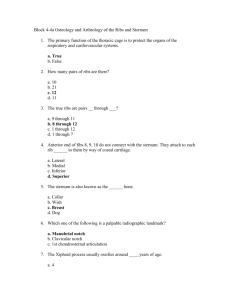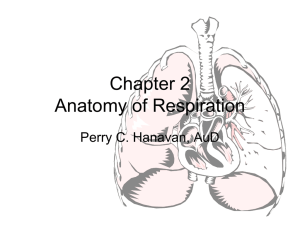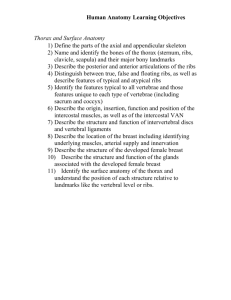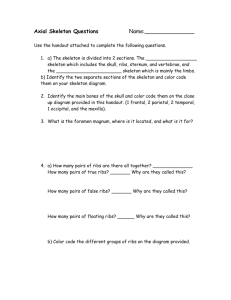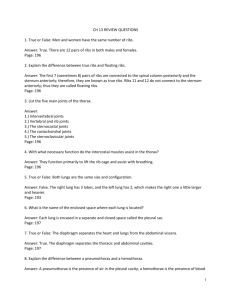Class #9 Chest Muscles and Bones
advertisement
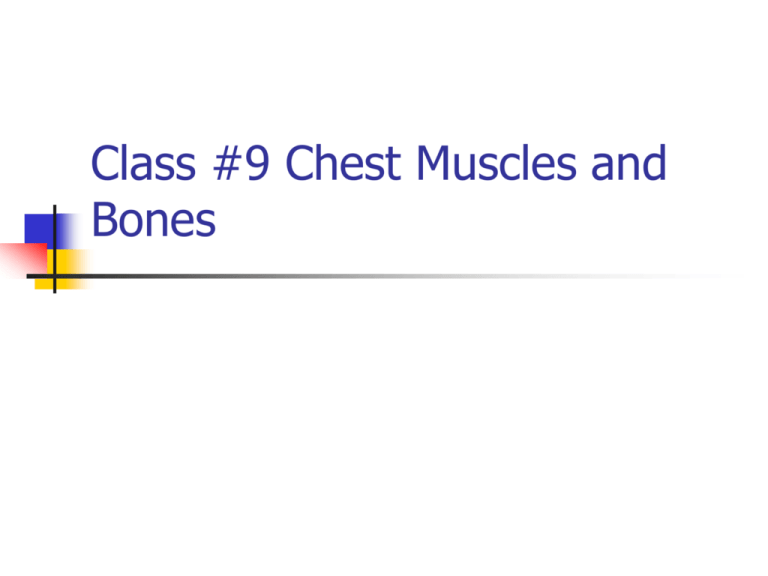
Class #9 Chest Muscles and Bones Clavicle p.4 Sternal End Acromical end Body Sternum p.4 Manubrium: Clavicular notch Jugular notch Body: sternal angle- where 2nd rib attaches to the body, it’s where the heart is. Xiphoid Process: be cautious of this during CPR, landmark for hand placement Ribs p.4 True: make a direct attachment to the sternum, 1st 7pairs False: attach anteriorly to each other by costal cartilages, pairs 8-10 Floating: have no anterior attachments, ribs 11 & 12 Chest and Abdomen Muscles: Pectoralis Major: Sternal and clavicular heads, forms anterior border of axilla O: Clavicle, sternum, upper 6ribs I: Lateral lip of bicipital groove A: Clavicular head-flexion of humerus at shoulder joint horizontal adduction. Sternal head-Flexion of humerous at shoulder joint Whole muscle-Adduction at shoulder joint medial rotation of humerus Pectoralis Minor *brachial plexus (bundle of nerves) runs just underneath, can get impinged. O: Ribs 3,4,5 I: coracoid process of scapula A: -Protraction -Depression -Downward rotation-pulls on coracoid in such a way that glenoid fossa is oriented downward. Subclavius O: 1st rib I: Clavicle Holds clavicle in place Intercostals 3 layers of muscle that lie between your ribs External- most superficial Fiber direction, like putting hands in pockets Inhalation/Inspiration Intercostals cont; Internal- Fiber direction, 90 degrees difference Exhalation/Expiration Innermost- Same fiber direction and same action as internal Transverse Thoracis- very deep, lies beneath xiphoid process Involved with expiration by depressing the ribs. Serratus Anterior O: lateral surface of upper 8 ribs Looks like serrated edge of knife—runs close to ribs and between ribs and scapula before: I: Anterior vertebral border of scapula A: Protraction, Holds scapula against ribs. Serratus Anterior cont: N: Long thoracic nerve Serratus Anterior Long Thoracic (jagged edge of knife, cut steak and then put SALT on it) Weak serratus anterior causes winging out of scapula Rectus Abdominis Pubic symphysis/crest > xiphoid process and costal cartilages of ribs 5,6,7. 2 masses separated by linea alba Anterior and Posterior rectus sheath cover and interconnect to form tendinous inscriptions Actions: Flexion of torso/trunk helps compress abdominal contents thereby supporting abdominal organs and assisting in forced expiration Diaphragm -Looks like a big mushroom -Primary muscle of respiration N: Phrenic Nerve -Flat muscle that divides chest from abdominal area. Diaphragm cont: -Has 3 openings (apertures) -Vena Caval foramen: allows for passage of inferior vena cava (brings back deoxygenated blood to heart) -Esophageal hiatus: esophagus passes thru here, about level of T10. Herniation can occur (hiatal herniastomach pops thru this opening) Diaphragm cont: -Aortic hiatus: about level of T12, descending portion of aorta, carrying oxygenated blood to body. Vena Cava = T8 Esophageal = T10 Aortic Hiatus = T12 Set Goals or Achieve Nothing! Now time for class assignment. Questions-Chest 1.Which muscle forms the anterior wall of the axilla? 2. What is the relationship between pectoralis minor and the brachial plexus? 3. What is the nerve supply to the respiratory diaphragm? 4. Name the openings of the respiratory diaphragm and what structures pass through each openings? Questions-Chest 5. A weak _____causes winging of the scapula? 6. State the origin, insertion and action for each muscle in this area: -Pectoralis Major and Minor -Subclavius -Intercostals -Serratus Anterior -Rectus Abdominis -Diaphragm Questions-Chest 7. List the bony landmarks of the chest: ribs, sternum, clavicle. The End! Quiz next class on the chest and abdominal muscles.
